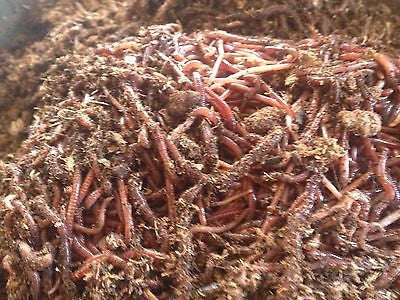Red Wiggler Worms available - Sustainable Waste Management Remedy
Red Wiggler Worms available - Sustainable Waste Management Remedy
Blog Article
Red Wiggler Worms Demystified: Unlocking the Secrets of Vermiculture for Greener Living and Nutrient-Rich Dirt
In the realm of lasting techniques for enriching soil high quality and advertising eco-conscious living, red wiggler worms play a pivotal yet often ignored function. Red Wiggler Worms. Understanding the details of caring for these worms, enhancing their environment, and utilizing their castings can lead to a greener lifestyle and healthier soil for plants to grow.
The Role of Red Wiggler Worms
Red Wiggler worms play a vital function in composting systems by efficiently breaking down organic matter right into nutrient-rich castings. These voracious eaters eat a selection of organic products, such as kitchen scraps, backyard waste, and paper products. As they feed, the worms' digestive system procedures damage down the raw material into a fine, dark, and nutrient-dense material known as worm spreadings or vermicompost.
The castings produced by Red Wiggler worms are highly beneficial for dirt health and plant growth. They are abundant in essential nutrients like phosphorus, potassium, and nitrogen, which are essential for supporting healthy and balanced plant growth. Furthermore, worm spreadings consist of helpful germs and enzymes that aid enhance soil framework, increase water retention, and improve nutrient uptake by plants.
Benefits of Vermicomposting

Moreover, vermicompost, the nutrient-rich output of vermicomposting, functions as an outstanding organic fertilizer and dirt conditioner. It enhances soil structure, enhances soil aeration, and enhances soil dampness retention. These residential properties add to much healthier plants with stronger root systems and far better resistance to parasites and illness. Vermicompost likewise enhances the dirt with crucial nutrients like nitrogen, phosphorus, and potassium, advertising plant development and total dirt fertility.
In addition, vermicomposting assistances sustainable horticulture methods by giving a chemical-free and natural option to artificial plant foods. Red Wiggler Worms. This eco-friendly method not just enhances the soil however also helps in reducing reliance on unsafe chemicals, promoting a greener and more sustainable method of horticulture
Establishing a Worm Container
When establishing a worm container for vermicomposting, correct configuration is crucial to ensure the success of the composting process. The primary step in establishing up a worm container is choosing a suitable container. This can be a plastic container or wooden box that provides enough space for the worms to move about and has appropriate drainage holes to stop waterlogging. Next off, a bed linen product such as shredded paper, cardboard, or coconut coir need to be included in the container. This bed linen gives a comfy atmosphere for the worms and assists preserve moisture levels.
After adding the bed linens, introduce the red wiggler worms to the bin. The worms must then be offered with food scraps such as fruit and veggie peels, coffee premises, and eggshells.
Routinely keep track of the moisture degrees and temperature level in the worm container to guarantee ideal conditions for the worms. With proper arrangement and maintenance, investigate this site the worm container will successfully transform natural waste into nutrient-rich compost for your plants and yard.
Collecting Worm Spreadings
To effectively gather nutrient-rich worm spreadings from your vermicomposting system, a systematic harvesting approach is crucial. When it comes time to collect the worm spreadings, there are a few vital steps to follow to make sure an effective procedure.

Troubleshooting Common Issues
Recognizing and attending to typical difficulties that might occur during the vermicomposting procedure is vital for preserving a healthy and balanced and productive worm bin. One usual problem that vermicomposters encounter is overfeeding. Including excess food scraps can lead to a buildup of moisture and acidity in the worm container, possibly damaging the worms. To avoid this, feed the worms in moderation, ensuring that the food scraps are properly damaged down before adding extra. An additional concern is undesirable odors originating from the worm container. Foul smells suggest anaerobic conditions, usually caused by overwatering or insufficient ventilation. To correct this, adjust the wetness levels by adding dry bed linen materials like shredded newspaper or cardboard and increase aeration by turning the bed linens routinely.
In addition, if the worm populace is declining or the worms show up harmful, maybe as a result of ecological stressors such as severe temperature levels or pH degrees. Keeping track of these aspects and making required modifications is vital for the health of the worms. By repairing these typical problems promptly, vermicomposters can ensure a smooth and effective vermicomposting procedure while maintaining a growing worm population.

Conclusion
In conclusion, red wiggler worms play an important role in vermiculture by breaking down natural matter right into nutrient-rich dirt. Setting up a worm bin is important for successful vermiculture, and gathering worm spreadings provides important garden compost for horticulture.
As they feed, the worms' gastrointestinal processes damage down the natural matter into a fine, dark, and nutrient-dense product recognized as worm castings or vermicompost.
The spreadings Web Site generated by Red Wiggler worms are very beneficial for dirt health and plant development. Adding excess food scraps can lead to a build-up of wetness and acidity in the worm bin, possibly harming the worms.In addition, if the worm population is decreasing or the worms show up harmful, it can be due to ecological stress factors such as severe temperatures or pH levels. Setting up a worm container is necessary for successful vermiculture, and harvesting worm spreadings offers valuable compost for gardening.
Report this page